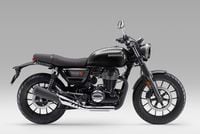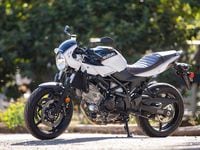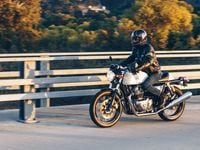Cafe Racers
Part of the retro resurgence, current cafe racers try to embody the British performance origins roots.
Conspicuous in the custom motorcycle scene, the cafe racer has found a resurgence in popularity in the past two decades, mainly from motorcycle manufacturers building factory cafe racers. Contemporary cafe bikes feature styling points from their vintage counterparts but lack the authenticity of its hooligan roots.
Cafe racer options today are plentiful, no matter if you want to build your own or purchase one from a manufacturer. Normally built off of a standard motorcycle platform, think of these bikes as a racier subgenre of that segment.
History Of The Cafe Racer
The name cafe racer provides most of the backstory to the style of bike. Cafe racers find their birthplace in post-World War II Britain, where car ownership was still low, particularly among young people. These youths, dubbed Rockers in the ’50s and ’60s, saw the motorcycle as more than a means of transportation—they saw it as access to the freedom they were not otherwise afforded because of income level and social standing in British society.
Pictured: One of the factory cafe racer models that Ducati has made, this being a 2001 MH900e.
Wallace Wyss, the famed American automotive writer and advertising consultant, stated that the term cafe racer should be attributed to a "motorcyclist who played at being an Isle of Man road racer" but was actually "someone who owned a racy machine but merely parked it near his table at the local outdoor cafe.” He was not entirely wrong because the Rockers of 1960 London used these modded motorcycles to race on England’s burgeoning highway system, to get from cafe to cafe as fast as they could. It was common to see multiple bikes parked outside of cafes like the Busy Bee and Ace Cafe in London.
During the 1960s, the cafe racer was almost exclusively a British-made motorcycle: Norton, Triumph, and BSA. As the motorcycle market expanded globally, Japanese motorcycles began their takeover of the factory cafe segment in the 1970s. During the latter half of the ’70s, BMW, Honda, Moto Guzzi, and even Harley-Davidson built factory cafe racer models. Most of these featured the common cafe racer styling, without any increase to performance over their standard motorcycle counterparts.
Most of these brands still continue to produce cafe racer variants of their motorcycle models, including manufacturers like Ducati, Kawasaki, Suzuki, Yamaha, and Husqvarna.
Latest Cafe Racers
What Is A Cafe Racer?
What makes a cafe racer, a cafe racer? If you ask a purist, they’ll say that it has to be a ’60s British—single- or twin-cylinder—motorcycle that has been stripped and tuned for performance. If you ask anyone else, they will say that it has to be a motorcycle with minimal bodywork, clip-on or clubman handlebar, a singular round headlight, a flat-slab solo seat, spoke wheels, and the foot controls should be sporty, not forward.
Closely related to the cafe racer—sharing some of its styling elements—are street trackers and brat bikes. A street tracker has that same, sporty race feel but with a higher handlebar and the foot controls are not as aggressively located, leaving you sitting more upright. A brat bike is essentially a cafe racer with a slab-style seat that can accommodate two-person riding. Some consider any Japanese motorcycle made into a cafe racer to be of the brat style.
Popular Cafe Racers
If you’re of the belief that it is better to build than to buy, there are a number of popular motorcycle models that you can turn some wrenches and transform into a cafe racer. One of the most popular—and easier to find—models is a Honda CB. These models were sold during the ’70s and ’80s and can be found on most CraigsList and marketplace-type communities. The CB500, 550, and 750 are the most coveted and you’ll probably pay the top dollar for any of them. Harder to find, but with an interesting engine configuration, is the Honda CX500.
Looking for a Yamaha donor bike? The XS series has a huge aftermarket support system that should make chopping it into a cafe racer dead simple. Another donor bike from Yamaha would be the Virago. Kawasaki’s W650 and W800 make great donor bikes and are the more modern of the list, with Kawasaki reviving the W800.
BMW has the R series that varies in engine displacement to suit any kind of build. If you’re looking to pay a premium, you could always go British for a true cafe racer. The Norton Manx is as close to legitimate factory cafe racer as one can get or you can save a little dough and scoop up a Triumph Trident or a Bonneville for a quick build.
Building a cafe racer is more about finding a suitable frame and engine that requires minimal modification. The more time you spend on working on the frame, the longer—and more expensive—the build will take. With the right amount of money and patience, you can turn most motorcycles into a cafe-style build.
Cafe Racers For Sale In 2024
Modern factory cafe racer options are plentiful from both Japanese and European motorcycle manufacturers. No matter your brand allegiance, you can find a bike that fits what you need.
Honda’s Neo-Sports Café motorcycle lineup includes the cafe racer-inspired Honda CB300R, CB650R, and CB1000R. The Kawasaki W800 and Z900RS Cafe are Team Green’s interpretation of the cafe style. Suzuki’s SV650 gets a cafe racer makeover for the 2019 model year with the Suzuki SV650X. Rounding out the cafe racer-styled options from Japan is Yamaha with the XSR700 and XSR900.
From one of the originators of the cafe racer style, Triumph offers the Thruxton as its true factory cafe option. The Ducati Scrambler lineup offers a Scrambler Cafe Racer or you could purchase a Monster and cafe it with off-the-shelf parts. The V7 III Racer from Moto Guzzi is one of the most detailed with a leather tank band that matches the bike’s color scheme. While KTM doesn’t offer any cafe options, its sister company Husqvarna offers the Vitpilen 401 and 701. BMW’s R nineT Racer is the Bavarian take on the genre powered by the iconic boxer twin. The styling of the Royal Enfield Continental GT 650 look as close to factory cafe racer as a manufacturer could build.
/cloudfront-us-east-1.images.arcpublishing.com/octane/M7WIAWC2IZCCVPYSS26OOFC4QU.jpg)
/cloudfront-us-east-1.images.arcpublishing.com/octane/SSOOM7QAEFATDHIOH475RPP4DA.jpg)
/cloudfront-us-east-1.images.arcpublishing.com/octane/KZ4PTCR4CRGXBBH56LZ5WLSDLE.jpg)
/cloudfront-us-east-1.images.arcpublishing.com/octane/XJU3VJZSDFEOVDBJTRXTTLTN5U.jpg)
/cloudfront-us-east-1.images.arcpublishing.com/octane/LUF3R527G5AURLB5WCP66HHH4I.jpg)



/cloudfront-us-east-1.images.arcpublishing.com/octane/67I2HKKVCEUDSTTFN3Z3KCG4NE.jpg)